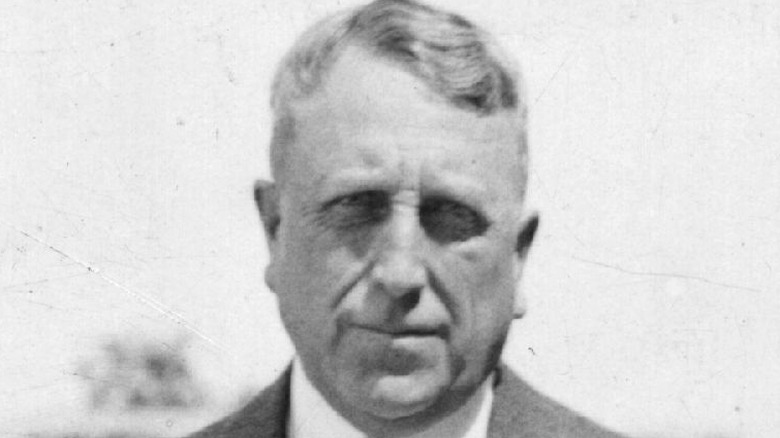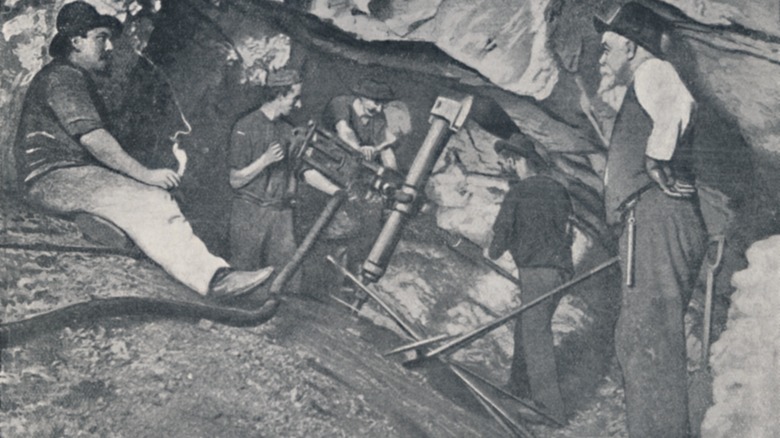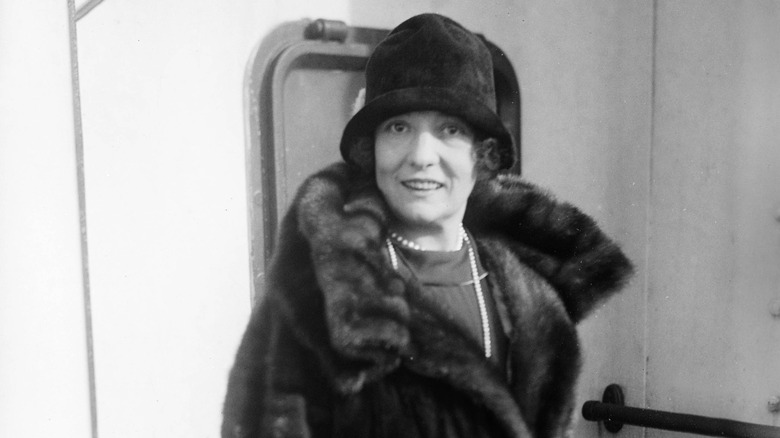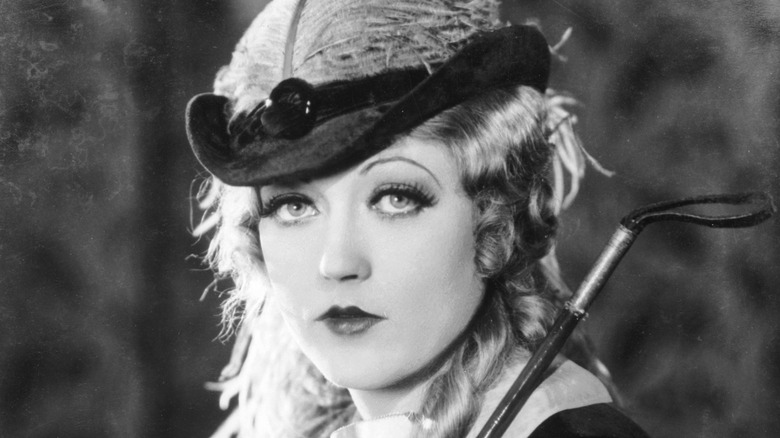William Randolph Hearst's Family Tree Explained
As something like the Mark Zuckerberg of the late 19th and early 20th centuries, William Randolph Hearst built a communications empire with newspapers, and in doing so, influenced the American way of life for generations to come. Today, there are several journalistic do's and don'ts that can be traced directly to the newspaper magnate, and through his forays into politics, his connection to high society, and even his relationship to Hollywood, Hearst remade the role of media in culture. His life story is immortalized in what many consider the greatest movie ever made, "Citizen Kane," per Britannica.
No one is alone when accomplishing what Hearst accomplished in his lifetime, however, and neither was Hearst. A closer examination of the Hearst family tree reveals nuance to the legendary media mogul's backstory, as well as interesting aspects of his legacy, still shaping and reshaping modern American culture and society. His family's story includes a father who gave him a boost in the newspaper business to a descendant embroiled in the cultural upheaval of the 1970s.
His father was also a millionaire
The archetype of the self-made millionaire is central to the American identity. Ask many for an example of this phenomenon in American history, and they just might mention William Randolph Hearst. According to Legends of America, though, Hearst's father, George Hearst, gave his son a head start, both in the newspaper business and in his bank ledger. Born in 1820, George Hearst was entrepreneurial from a very young age, improving the bottom line of the family farm following the death of his father, launching and running a successful store, and dabbling in the lead mining industry, a major employer in Hearst's home state of Missouri.
It's within that mining industry that the roots of the Hearst fortune truly lie. By the 1850s, George Hearst, already successful in lead mining, moved his family to California to try his hand at gold mining (in mines similar to what's pictured). Out West, he had mixed results, but still managed to realize enormous profits. William Randolph Hearst was born in 1863, per Britannica. By the 1880s, his father, George, was in the San Francisco newspaper business, owning and operating the San Francisco Examiner.
By 1887, George Hearst handed the newspaper over to his son who, through a mix of gossipy and sensationalist "yellow journalism" and real human interest stories, made the paper wildly profitable. Much of that success can be attributed to the younger Hearst, but for a leg-up in any industry, having a business given to you by your father is not a bad place to start.
His mother-in-law allegedly ran a brothel
A common theme in the life of William Randolph Hearst is an attraction to glitz and glamor. An early example of this aspect of his personality shows up when he marries Millicent Wilson (pictured above) in 1903, a New York showgirl, via Biography. Hearst also displays some political savvy in this arrangement, and he'd later run for office. Wilson's mother purportedly ran a brothel in the city, closely entangled with Tammany Hall and the political elite of the Democratic Party at the time, with which Hearst was associated. If Hearst had political ambitions, marrying into a family that knew intimately the foibles of Democratic politicians would no doubt prove advantageous.
According to Head Stuff, Hearst's mother, Phoebe Hearst, still controlled the young man's finances when he married, and she was not pleased with her son when he chose to wed someone from the lower classes, like a showgirl. When Millicent began producing grandsons for Phoebe Hearst, however, for a total of five, and each going into the newspaper industry, the Hearst matriarch may very well have changed her mind. Although Millicent Hearst would seek a divorce in the 1930s, the couple stayed together for the remainder of their lives, per Hearst Castle, the website of the landmark Hearst dwelling which can still be visited to today. Following the birth of their fifth and final son, William Randolph Hearst had romantically strayed from the marriage with the actress and classic Hollywood star Marion Davies, widely considered to be the love of his life.
He had a daughter with Marion Davies
William Randolph Hearst was 53 when he met Marion Davies, who was only 19 at the time, according to the New York Post. Like his wife Millicent, Davies was a showgirl, performing in the "1916 Follies," and Hearst quickly began to woo the young star, who had aspirations for Hollywood success. The couple were soon living together in New York, although Hearst remained married, and he supported her performance career with preferential treatment in his newspapers, while also turning a blind eye to her alcoholism and extravagant lifestyle. To take Davies closer to Hollywood, where she'd make her name in the silent movie industry of the time, and also perhaps to get her farther away from his wife, Hearst moved Davies into his San Simeon "castle" and a Beverly Hills Estate.
Although Davies never married Hearst, she did intersect with his family tree in one particular instance. In the 1920s, Patricia Van Cleve Lake was born, per The Life and Times of Hollywood. As a young woman, Van Cleve Lake was raised in Hearst's San Simeon mansion, mixing with stars like Charlie Chaplin and Gloria Swanson at Davies' notorious industry parties. She was, however, only ever referred to as Davies' "niece," and few questioned that version of the story, at least not in public. In a deathbed confession to her son, after both Hearst and Davies had died, Patricia Van Cleve Lake admitted she was actually the daughter of William Randolph Hearst and Marion Davies.
Patty Hearst was his granddaughter
William Randolph Hearst's granddaughter Patty Hearst made headlines in 1974 for reasons very far removed from the world of classic Hollywood fame and fortune. That year, Patty Hearst (pictured above, later in life) was abducted by the Symbionese Liberation Army (SLA), a violent leftist political organization interested in using her for ransom, demanding food and money donations be made to underprivileged people of California on behalf of the Hearst estate, per History.
William Randolph Hearst's son Randolph Hearst, Patty's father, complied with these terms, conditionally, so long as his daughter was released safely. Eventually, though, security footage showed Patty participating in a bank heist in the San Francisco area, and later, she revealed that she had, in fact, joined forces with the SLA of her own accord. Hearst changed her name to "Tania" and traveled across the country before she was arrested for armed robbery. At this point, Patty Hearst claimed she had not joined the SLA willingly at all, but instead, she had been brainwashed. Nevertheless, she served 21 months of a seven-year prison sentence before President Jimmy Carter commuted her sentence and she was released. Patty Hearst was eventually pardoned by President Bill Clinton in the 1990s.
The Hearsts are still among America's wealthiest families
Although most members of the Hearst family keep a much lower profile these days than they once did, they're still among the wealthiest families in the country, with several continuing to work in the publishing industry as it exists today. William Randolph Hearst's son, William Randolph Jr., shared a Pulitzer award in 1956 for his war coverage of the Soviet Union, as The New York Times reported in his obituary. According to Love Money, Hearst Communications continues to provide $11.5 billion in revenue annually for the Hearst clan, with a net worth of $21 billion. Even today, the descendants of William Randolph Hearst hover around the top 10 wealthiest people in the United States, according to most estimates, and New York's Hearst Tower (pictured above) continues to be the epicenter for publishing, as the family business also dabbles in the credit reporting industry.
Bridging the 19th and 20th centuries, few family stories track the arc of recent American history like that of William Randolph Hearst. With several descendants of the publishing impresario still alive and working at the highest levels of society, that story appears to be far from over.





